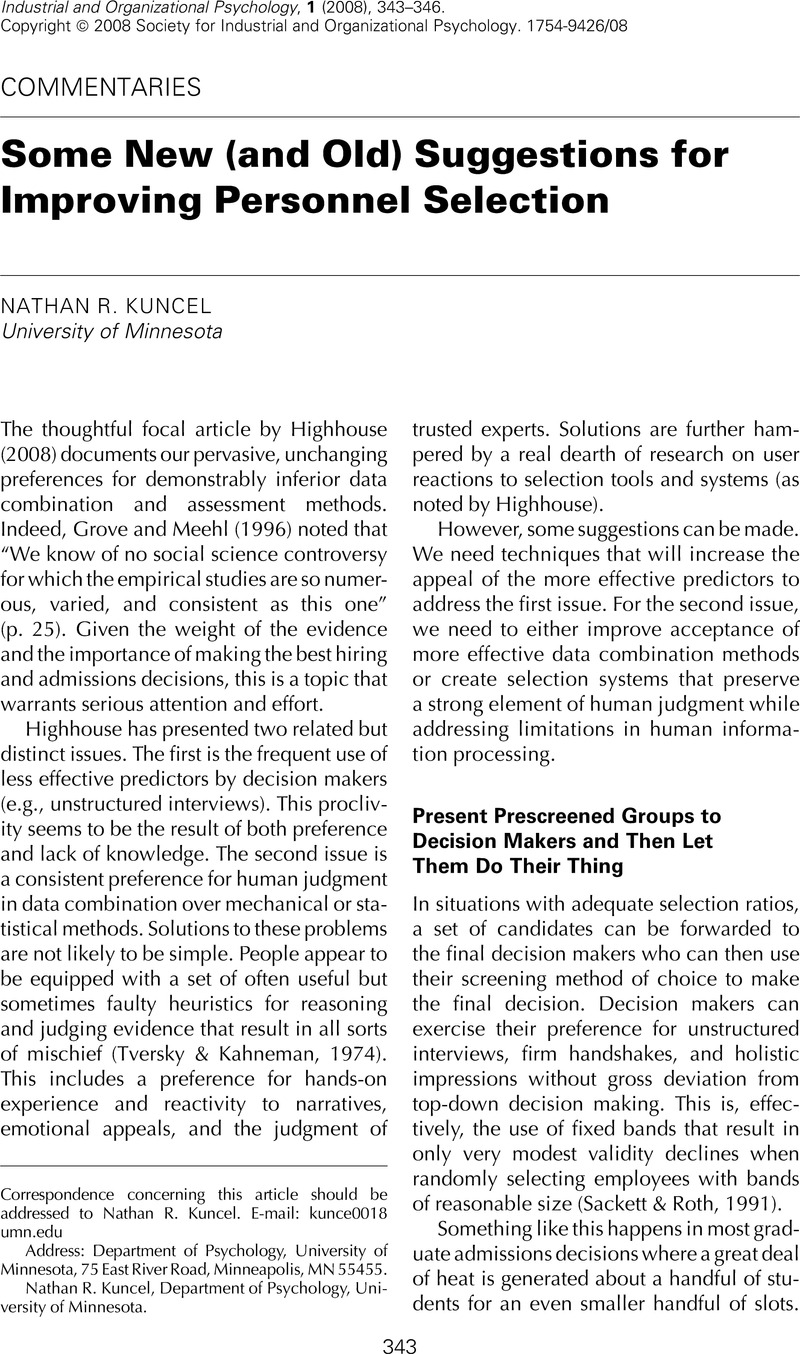Crossref Citations
This article has been cited by the following publications. This list is generated based on data provided by Crossref.
Highhouse, Scott
2008.
Facts Are Stubborn Things.
Industrial and Organizational Psychology,
Vol. 1,
Issue. 3,
p.
373.
Dalal, Reeshad S.
Bonaccio, Silvia
Highhouse, Scott
Ilgen, Daniel R.
Mohammed, Susan
and
Slaughter, Jerel E.
2010.
What If Industrial–Organizational Psychology Decided to Take Workplace Decisions Seriously?.
Industrial and Organizational Psychology,
Vol. 3,
Issue. 4,
p.
386.
Kuncel, Nathan R.
and
Highhouse, Scott
2011.
Complex Predictions and Assessor Mystique.
Industrial and Organizational Psychology,
Vol. 4,
Issue. 3,
p.
302.
Diab, Dalia L.
Pui, Shuang-Yueh
Yankelevich, Maya
and
Highhouse, Scott
2011.
Lay Perceptions of Selection Decision Aids in US and Non-US Samples.
International Journal of Selection and Assessment,
Vol. 19,
Issue. 2,
p.
209.
Klehe, Ute-Christine
2011.
Scientific Principles Versus Practical Realities: Insights From Organizational Theory to Individual Psychological Assessment.
Industrial and Organizational Psychology,
Vol. 4,
Issue. 3,
p.
311.
Lodato, Michael A.
Highhouse, Scott
and
Brooks, Margaret E.
2011.
Predicting professional preferences for intuition‐based hiring.
Journal of Managerial Psychology,
Vol. 26,
Issue. 5,
p.
352.
Nolan, Kevin P.
and
Highhouse, Scott
2014.
Need for Autonomy and Resistance to Standardized Employee Selection Practices.
Human Performance,
Vol. 27,
Issue. 4,
p.
328.
Ryan, Ann Marie
and
Ployhart, Robert E.
2014.
A Century of Selection.
Annual Review of Psychology,
Vol. 65,
Issue. 1,
p.
693.
Kausel, Edgar E.
Culbertson, Satoris S.
and
Madrid, Hector P.
2016.
Overconfidence in personnel selection: When and why unstructured interview information can hurt hiring decisions.
Organizational Behavior and Human Decision Processes,
Vol. 137,
Issue. ,
p.
27.
Zhang, Don C.
Highhouse, Scott
Brooks, Margaret E.
and
Zhang, Yuyan
2018.
Communicating the validity of structured job interviews with graphical visual aids.
International Journal of Selection and Assessment,
Vol. 26,
Issue. 2-4,
p.
93.
Zhang, Don C.
Zhu, Xiaoyuan (Susan)
Ritter, Kelsey‐Jo
and
Thiele, Aneeqa
2019.
Telling stories to communicate the value of the pre‐employment structured job interview.
International Journal of Selection and Assessment,
Vol. 27,
Issue. 4,
p.
299.
Meijer, Rob R.
Neumann, Marvin
Hemker, Bas T.
and
Niessen, A. Susan M.
2020.
A Tutorial on Mechanical Decision-Making for Personnel and Educational Selection.
Frontiers in Psychology,
Vol. 10,
Issue. ,
Burton, Jason W.
Stein, Mari‐Klara
and
Jensen, Tina Blegind
2020.
A systematic review of algorithm aversion in augmented decision making.
Journal of Behavioral Decision Making,
Vol. 33,
Issue. 2,
p.
220.
2020.
Enabling Corporate Sustainability from a Talent Acquisition Perspective.
Journal of Sustainability Research,
Vol. 2,
Issue. 2,
Neumann, Marvin
Niessen, A. Susan M.
and
Meijer, Rob R.
2021.
Implementing evidence-based assessment and selection in organizations: A review and an agenda for future research.
Organizational Psychology Review,
Vol. 11,
Issue. 3,
p.
205.
Lee, Samuel David
Walmsley, Philip T
Sackett, Paul R.
and
Kuncel, Nathan
2021.
A Method for Displaying Incremental Validity with Expectancy Charts.
Applied Measurement in Education,
Vol. 34,
Issue. 4,
p.
251.
Zhu, X. Susan
Wolfson, Mikhail A.
Dalal, Dev K.
and
Mathieu, John E.
2021.
Team Decision Making: The Dynamic Effects of Team Decision Style Composition and Performance via Decision Strategy.
Journal of Management,
Vol. 47,
Issue. 5,
p.
1281.
ZAHNG, Yuyan
XU, Liying
YU, Feng
DING, Xiaojun
WU, Jiahua
ZHAO, Liang
邬, 家骅
and
赵, 靓
2022.
A three-dimensional motivation model of algorithm aversion.
Advances in Psychological Science,
Vol. 30,
Issue. 5,
p.
1093.
Yu, Martin C.
and
Kuncel, Nathan R.
2022.
Testing the value of expert insight: Comparing local versus general expert judgment models.
International Journal of Selection and Assessment,
Vol. 30,
Issue. 2,
p.
202.
Niessen, A. Susan M.
Kausel, Edgar E.
and
Neumann, Marvin
2022.
Using narratives and numbers in performance prediction: Attitudes, confidence, and validity.
International Journal of Selection and Assessment,
Vol. 30,
Issue. 2,
p.
216.



